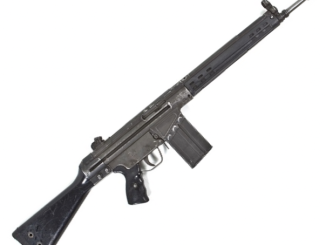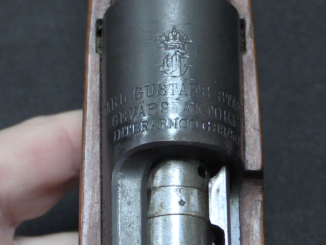When Sweden decided to replace its Remington Rolling Block rifles with a more modern repeating rifle design, they tested models from Mauser, Mannlicher, Lee, and Krag. The Mauser 1893 was chosen as the winner of the competition, with a few modifications (most notably a change to allow the safety to be engaged whether the striker was cocked or not). A carbine was adopted first – the infantry rifle would follow a few years later. An initial batch of m/1894 carbines was purchased from Mauser Oberndorf, to start the military transition while the Carl Gustav factory tooled up to begin licensed production.
The original m/94 Swedish carbines used a heavy nosecap to protect the front sight, but did not have a fitting for a bayonet. This was changed in 1914, with new production guns being fitted with a Lee-Enfield style bayonet lug below the muzzle (and many existing carbines were updated to this new configuration) and designated the model m/94-14. Production continued sporadically until 1932, with most of the guns being made in the first decade of the 20th century and during World War One.
Interestingly, Sweden did not adopt a spitzer version of the 6.5x55mm cartridge until 1941 – much later than most other nations. When this was done, the sights on the existing carbines were not modified. Instead, a range conversion table was affixed to the right side of the stock, indicating proper sight settings and holdovers for using the new ammunition.




This type of article is the reason I signed up. One of my favorite rifles. I love the ventage rifle game.
“Sweden did not adopt a spitzer version of the 6.5x55mm cartridge until 1941 – much later than most other nations. When this was done, the sights on the existing carbines were not modified. Instead, a range conversion table was affixed to the right side of the stock, indicating proper sight settings and holdovers for using the new ammunition”
This seems as potentially error creating solution. How did they solve problem of new ballistic in case of KulspruteGevar m/1921:
http://modernfirearms.net/machine/swed/kg_21_27-e.html
?
“Sweden did not adopt a spitzer version of the 6.5x55mm cartridge until 1941”
But there existed 6,5×61 cartridge
http://deutsches-jagd-lexikon.de/index.php?title=6,5×61
states Swedish forces, were looking for replacement of 6,5×55 cartridge, this cartridge was developed by DWM for that task, but it was not adopted and become hunting cartridge (it also get rimmed sister – 6.5×61 R); this cartridge spawned 5,6×61 Super Express vom Hofe cartridge.
Dimensions and photos of 6.5×61 cartridge:
http://www.municion.org/6_5x55Krag/6_5x61Xpl.htm
I presume that they designed military loading using Spitzer bullets (see 1st photo from top), when that second shown cartridge is hunting version, though I have not source.
Perhaps the Swedes didn’t change ammunition projectiles because there was no perceived need for such…
Like one of the other 6.5mm cartridge users, namely, Italy. Carcano 6.5x52mm never went spitzer either. How about odd 6.5s like Portugal’s Vergueiro 6.5x58mm, or the Dutch/Romanian 6.5mm Mannlicher cartridge?
Even without Spitzer bullets, 6.5×52 Carcano is NASTY to anyone on the receiving end. Kennedy found out the hard way…
Umm. Yeah. That bullet that ploughed through his back, came out of his throat, then hit Governor Conally went through his body, exited, smashed his wrist, and thent went through his thigh … And then turned up on the gurney at the hospital almost intact except for every land and groove that linked it to the 6.5mm Oswald Carcano carbine. Oh, you mean the head shot on the Zapruder film? Yeah. nasty indeed.
The 6th floor museum replicated the fatal shot establishing that Oswald could certainly have done it, and the wound may have been exactly as it appears on film. Bugliosi published _Case Closed_ to nail down the lid on the casket. And after 9/11, everyone loathes conspiracy theorists. Truth be told, many of them are really duplicitous and even vile.
But then ol’ Antonio Veciana Blanch, b. 1928, i.e. as old as the late Fidel Castro Ruz, but an accountant and banker and CIA asset–and founder of Alpha 66 comes out with his memoirs and claims, not implausibly, that David Atlee Philips, his handler, met one Soviet-defector who came back married to Marina named Lee Harvey Oswald. This two weeks before JFKs untimely end at Dealy Plaza in Dallas…
28 June 1963, Tony Varona, John Roselli of Chicago, Carlos Marcello of NOLA and by extension Dallas, and Santo Traficante of Tampa were all apparently enlisted in yet another anti-Castro assassination/overthrow scheme, this one called “AMWORLD.” Maybe we might find out more details in a few years…
As for 6.5mm, there are some admittedly grisly “wound ballistics” studies undertaken by the U.S. in light of the very many ghastly wounds inflicted during WWII… Apparently the 6.5x50SR Japanese produced really ugly wounds, and the jacket typically separated from the core, producing another wound track in victims shot with it. You will recall, I’m sure, that during studies before WWII, the .276 Pedersen was analyzed alongside a 6.5mm small-bore cartridge and a .30 cal. service cartridge. Supposedly the wounds produced by the .256/6.5mm were the most fearsome, but the long range ballistics argued for the 7mm/.276 until MacArthur decided that U.S. ammunition stocks, production lines, and long-range MGs all argued for retention of the .30-06. Even though the U.S. sold about a quarter of those ammunition stocks in June 1940 to the hard-pressed, post-Dynamo/Dunkirk UK for use in U.S. MGs and rifles… Who knows? Even now, the 6.5mm cartridges may come up for some sort of reassessment as small arms developments may begin anew after the long plateau of the post-Cold War…
Even more so than 5.56mm 55-grain with 1 in 12″ pitch rifling, 6.5mm bullets tend to break up on penetration, especially after hitting bone.
The reason, according the U.s. Army Wound Ballistics Laboratory report of 1956, is a combination of their relatively long length to beam ratio combined with their velocity. The slower rifling pitch (average 1 to 22.5″) used with such bullets in the 140 to 160-grain range makes them stable in air, enhancing their accuracy out to 600 meters or so. But this same relatively slow rotational rate combined with the L/B ratio causes them to tumble almost instantly upon hitting flesh and bone, usually resulting in bullet disruption.
Interestingly, the Italian-made 6.5 Carcano rounds had a two-piece bullet core, with the front 1/3 made of aluminum. It also had a small airspace at the tip, inside the jacket nose. The idea was to increase the chances of bullet expansion on impact, without violating the Hague Convention; it wasn’t a “hollow point” or “dum dum” bullet, just a full-metal-jacket with an unusual core.
The Japanese 6.5mm Arisaka used bullets with plain, simple lead or mild steel cores that filled the jacket completely. They still tumbled on impact and in the case of the lead cored ones, disrupted, just like the complicated Italian bullets.
The rounds Oswald used were not Italian. They were made in the U.S. at the Lake City Arsenal in 1945 for the Italian Co-Belligerent Forces. They had plain lead cores because the U.S. didn’t have the time or interest to manufacture complicated “special” bullets. (Making tracers and etc. was enough of a strain on resources at the time.)
The results in Dallas showed that the exact internal structure of a 6.5mm bullet of the typical design has much less to do with its wounding and killing capability than its overall shape and ballistics. I.e. a 140 to 160 grain, 6.5mm bullet at 2,600 F/S or so, is going to make a mess when it hits, period.
cheers
eon
“Even now, the 6.5mm cartridges may come up for some sort of reassessment as small arms developments may begin anew after the long plateau of the post-Cold War…”
6.5 mm calibers seems to be well-liked by long range shooting, examples are 6.5-284 NORMA, 6.5×47 LAPUA or from less popular one 6.5×63 Messner Magnum (it has also rimmed sister):
http://www.municion.org/Messner/Rimless.htm
which was spawned by 9.3×64 Brenneke, there also exist more hunting-minded cartridge, as 6.5x68mm, which is good choice when flat trajectory is need, similar role is full-filed by 6.5×65 RWS introduced much much later (6.5×68 in 1939, 6.5×65 in 1999)
Description of 6.5×65 RWS:
https://rws-munition.de/en/rws-hunting-area/rws-hunting-ammunition/rws-centerfire-rifle-cartridges-for-hunters/Product/show/65×65.html
There also existed Soviet 6.5×54 R for competition used, which was spawned by 7.62×54 R: http://www.municion.org/6_5rR/6_5rR.htm
I refer to the so-called “Pig” Board tests carried out by U.S. Ordnance between June and July 1928, published that September. The .256-cal./.264 cal. “6.5s” were found to be plenty lethal on anesthetized swine executed with various cartridges in pursuit of a self-loading rifle that would be as light and handy as the ’03 Springfield, and possibly replace both the manually-operated bolt-action flinch-inducing shoulder rifle and possibly the B.A.R. too. 8 gram bullets at >2,500fps much as eon described. That Swedish 6.5×55 BAR m/21 and m/37 posted by Daweo makes one wonder, no?
As it happened, the 1932 Garand rifle prototype was lighter than the WWII rifle and had a ten shot “either side up” en-bloc clip for .276 Pedersen cartridge. Too many calibers it was decided: “Can’t we just have .45 acp and .30-06?” So instead U.S. Ordnance adopted .30 U.S. carbine into the mix because the Garand rifle couldn’t be made any smaller or lighter. And as noted by Euroweasel, the Swedes–who remained ostensibly neutral throughout the war unlike Finland or the United States–had 9×20 long, 9×19 parabellum, 6.5x55mm, and 8x63mm for HMGs and fortresses and so on.
Problem with 6,5 mm Spitzer bullet, might be beyond different ballistic, fact that Spitzer would be dimensionally smaller (lighter) than “torpedo” bullet, as overall length of cartridges can’t be greater for new bullet. This might be not great issue with standard (FMJ or Ball in U.S. parlance) bullets, but mean less effective TRACER rounds and less effective HE (were such cartridges used by Swedish forces?)
Not too many rifle-caliber HE bullets used in WW2 and even today they are rare. In fact the German B bullet was the only true HE bullet I’m aware of. Did you perhaps mean incendiary bullets? As far as tracers go, smaller caliber would have a shorter burn time, but since the 6.5mm cartridges also had a shorter effective range, that would probably not have been an issue.
To my knowledge the Swedes did not have incendiary bullets for the 6.5mm cartridge. Finnish war time documents have no mention of such bullet. True incendiary bullets, where the incendiary mass is ignited at impact were 1930s developments, but in 1932 the Swedes adopted the 8×63mm cartridge for heavy and medium machine guns, so there would have been little need for an incendiary bullet in 6.5×55mm. Although not impossible, it would have been difficult to develop an effective incendiary bullet for such a small caliber.
“In fact the German B bullet was the only true HE bullet I’m aware of.”
Does this Austrian WW1 cartridge:
https://ru.wikipedia.org/wiki/Файл:Природа_и_люди_37_Разрывные_австрийские_пули.jpg
count as HE?
“odd 6.5s”
Does Greek forces used Spitzer bullet in their 6,5 mm Mannlicher-Schönauer rifles or does they stayed with round nose bullets?
No interest in these, and Ian’s knowledge and enthusiasm made me want one after watching the video. My mom’s family left Sweden before these came out, but it would still be a neat piece of heritage to own.
So much for a bargain on that one…
I just realized what my rifle was but it is a m 94 that was given you me by my grandpa this video was very informative I just wish I had a way to find out how much its worth it is carl gustafs stad 1904